

Kawasaki ZXR400 R Specs (H1/H2 models – 1989 to 1990)…..
The Kawasaki ZXR400 H (aka ZXR400R) was a fully faired sports bike that was manufactured in Japan between 1989 and 1990 and unofficially imported into the UK (sold as a ‘grey market’ bike).
As with alot of Jap import bikes, the ZXR400 had features that put many of the bigger (600, 750) cc bikes to shame, like upside down forks, alloy frame, 17 inch wheels and a screaming engine!
. The ZXR400 H was replaced in 1991 by the ZXR400 L, which was available officially from Kawasaki UK.
Servicing your bike? You’ll need a ZXR400 workshop manual…
Basic model info… |
|
|---|---|
| Manufacturer: | Kawasaki |
| Model: | ZXR400 H |
| CC: | 398cc |
| Engine type: | Inline 4 cylinder (4 stroke) |
| Years in production: | 1989 to 1990 |
| Years reg marks: | 1989 – F reg 1990 – G reg |
| Official UK bike?: | No, only available as a grey (non official) import (the ZXR400 H was not available new in the UK, only as a used, import bike) |
| Kawasaki model code: | ZX400 |
| Style of bike: | Sports bike (fully faired) |
| Replaced by: | ZXR400 L |
| Insurance: | Group 12 insurance (of 17) |
Looking for ZXR 400 parts? Buy ZXR400 spares on Amazon…
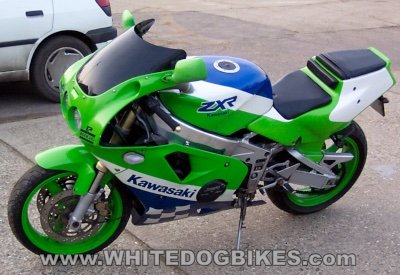
Side/front view of a 1989 ZXR400 H1
Kawasaki ZXR400 Specs…
| Engine and gearbox stuff… | |
|---|---|
| Displacement: | 398 cc |
| Engine type: | Inline four cylinder, four-stroke |
| Cam configuration: | DOHC (double overhead cam shafts) |
| Number of cylinders: | 4 |
| Cylinder firing order: | 1 – 2 – 4 – 3 |
| Compression ratio: | 12.1 |
| Bore and stroke: | 57.0 x 39.0mm |
| Cylinder compression: | 686 to 1079 kpa |
| Power: | 62 HP (45.6 kw) @ 12500 RPM |
| Torque: | 39.2 Nm (4.0 kg-m or 29 ft.lbs) @ 10000 RPM |
| Clearance between piston ring and cylinder bore: | 0.043mm (when new) to 0.070mm (max clearance) |
| Valves per cylinder: | 4 (16 valves in total) |
| Inlet valve clearance (with cold engine): | 0.131mm to 0.140mm |
| Exhaust valve clearance (with cold engine): | 0.85mm to 0.180mm |
| Cam shafts: | Double overhead cams (DOHC) |
| Fuel type: | Petrol (unleaded petrol – 95/4 grade, e.g. petrol from your local garage) |
| Engine oil capacity: | 3 litres |
| Oil pressure: | 216 to 275 kpa (31 to 40 psi) at 4000 rpm and 90 degrees centigrade oil temp |
| Oil system: | Forced lubrication (oil pump) from an oil sump with oil cooler |
| Oil pump: | Trochoid type oil pump |
|
|
| Recommended engine oil: | 10w40 Semi synthetic
|
| Engine oil capacity: | 3 litres |
| Engine oil filter capacity: | 0.2 litres |
| Oil filter: | Hiflo HF303 / Champion F306 |
| Oil change interval: | 5000km or 12 months (approx) |
| Cooling system: | Liquid cooled |
| Cooling system capacity: | 2.3 litres |
| Cooling system change interval: | Change every 30,000km or 24 months (approx) |
| Clutch: | Wet, multi plate type clutch |
| Clutch part no: | EBC CK4446 (plates) and EBC CSK007 (springs) |
|
|
| Clutch operation: | Mechanical – Operated by a clutch cable and lever |

Side/back view of a ZXR400 H
| Final drive stuff… | |
|---|---|
| Final drive: | chain |
| Chain length: | 108 link |
| Chain pitch: | 520 |
| Free play: | 20 to 35mm |
|
|
| Front sprocket: | 15 teeth |
| Front sprocket clamp torque: | 10nm |
| Rear sprocket: | 45 teeth |
| Rear sprocket bolts torque: | 74nm |

ZXR400 H carbs
| Fuel and carb stuff… | |
|---|---|
| Fuel type: | Petrol (unleaded petrol – 95/4 grade, e.g. petrol from your local garage) |
| Recommended fuel: | 4 stroke / 95 octane |
| Carb: | Keihin CVK-D32 (x 4) |
| Idle speed: | 1200rpm (+/- 50rpm) |
| Pilot screw setting: | 2 1/4 turns out (2 and a quarter) |
| Float height: | 11mm (+/- 2mm) |
| Throttle grip free play: | 2 to 3mm |
| Choke cable free play: | 2 to 3mm |
|
|
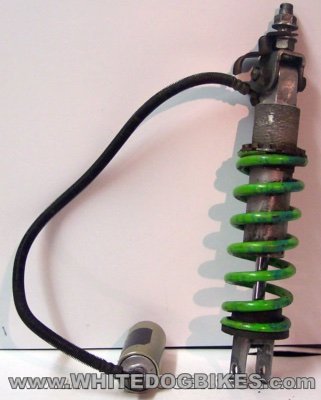
ZXR400 H back shock absorber
| Suspension, brakes and wheel stuff… | |
|---|---|
| Front brakes: | Twin (dual) 300mm floating discs |
| Front brake caliper: | Tokico 4 pot caliper |
| Front caliper bolt torque: | 34nm |
| Front disc part numbers: | EBC MD4008X (x2, left and right disc) |
| Front brake pad part number: | EBC FA158 |
| Upgrade front brake pad part number: | EBC EPFA158HH (double H sintered brake pads) |
|
|
| Rear brake: | Single 240mm solid disc |
| Rear brake caliper: | Tokico 1 (single) pot caliper |
| Rear caliper bolt torque: | 25nm |
| Rear disc part number: | EBC MD4009 |
| Rear brake pad part number: | EBC FA161 |
| Recommended brake fluid: | DOT 4 brake fluid |
| Brake fluid change interval: | Check every 5,000km and change every 20,000km or 24 months (approx) |
| Brake hose banjo bolt torque: | 25nm |
| Bleed nipple torque: | 7.8nm |
| Front wheel: | 3 Spoke cast |
| Front tyre size: | 120/60-17 |
| Front tyre pressure: | 32psi |
| Front spindle nut torque: | 110nm |
| Front spindle clamp bolt torque: | 20nm |
| Rear wheel: | 3 spoke cast |
| Rear tyre size: | 160/60-17 |
| Rear tyre pressure: | 36psi |
| Rear spindle nut torque: | 110nm |
| Front suspension: | 41mm Upside down forks |
| |
| Stanchion diameter: | 41mm |
| Recommended fork oil: | Light – 5w Fork oil |
|
|
| Fork oil capacity (oil change): | 355ml per fork |
| Fork oil capacity (if forks have been rebuilt and all old oil removed): | 421ml per fork |
| Fork oil change interval: | 24,000km (14912 miles) or 2 years (approx) |
| Rebound damping setting: | 6th Click from fully counterclockwise position |
| Spring preload setting: | 1/4 (one quarter) turn out from fully counterclockwise position |
| Rear suspension: | Single rear monoshock with adjustable preload and rebound damping |
| Rebound damping setting: | Number 1 of 4 positions |
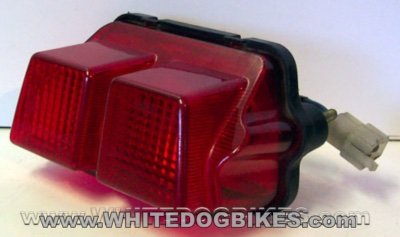
ZXR400 H rear light
| Weights ‘n measures… | |
|---|---|
| Dry weight (no oils, fuel etc): | 163kg |
| Seat height: | 765mm |
|
|
| Wheelbase: | 1395mm |
| Length: | 2035mm |
|
|
| Width: | 705mm |
| Height: | 1125mm |
| Ground clearance: | 120mm |
| Min turning radius: | 3.2 meters |
| Fuel tank capacity: | 16 litres |
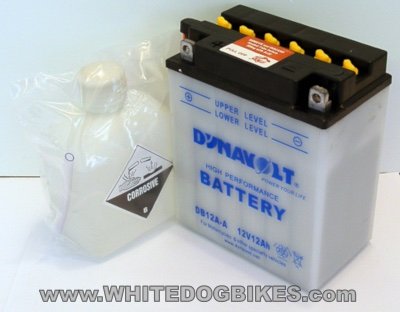
Kawasaki ZXR400 H battery (YB12A-A).
| Electrical stuff… | |
|---|---|
| Starter: | Electric starter motor |
| System voltage: | 12 volts |
| Alternator rated output: | Not less then 43 volts at 4000rpm / 23 amps at 10,000rpm |
|
|
| Voltage regulated by: | Regulator/rectifier |
| Regulator/rectifier location: | Underneath the rear/pillion seat, just by the seat release mechanism. |
| |
| Battery voltage capacity: | 12volts / 10amps |
| Battery: | YB12A-A / CB12A-A / DB12A-A |
| |
|
|
| Ignition type: | Electronic IC Ignitor (similar to a CDI) |
| |
| CDI / IC Ignitor location: | Underneath the rear/pillion seat, just by the seat release mechanism. |
| CDI / IC Ignitor Kawasaki part number: | 21119-1271 |
| |
|
|
| Spark controlled by: | 2 x coil |
| |
| Spark plug: | NGK CR9EK (x4) |
| Spark plug gap: | 0.7 to 0.8mm |
| Ignition timing (BTDC): | 12.5 degrees BTDC at 1200rpm 45 degrees BTDC at 6000rpm |
| Ignition advance: | Electronic advance |
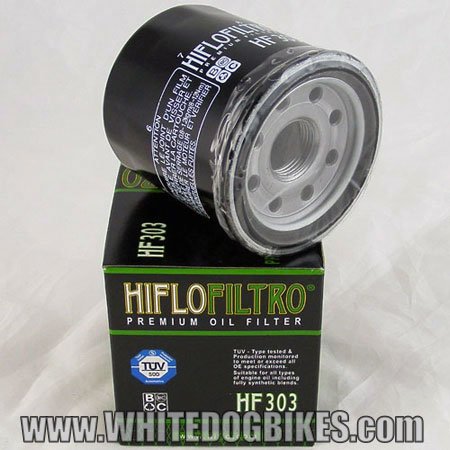
Kawasaki ZXR400 H oil filter (Hiflo HF303).
| Servicing stuff… | |
|---|---|
| If your new to servicing or unsure, either ask a friend to help or get a ZXR400 workshop manual… | |
| |
| Engine oil change: | |
| Oil change interval: | 5000km (3107 miles) or 12 months |
| Engine oil capacity (including oil filter change): | 3 litres |
| Engine oil capacity (excluding oil filter change): | 2.8 litres |
| Engine oil filter capacity: | 0.2 litres |
| Recommended engine oil: | 10w40 Semi synthetic |
|
|
| Oil filter: | Hiflo HF303 / Champion F306 |
| Air filter: | |
| Air filter: | Kawasaki part no: 11013-1168 |
| Change interval: | 12000km (7456 miles) |
| Spark plugs: | |
| Spark plug: | 4x NGK CR9EK |
| Change interval: | 6000km (3728 miles) |
| Cooling system: | |
| Cooling system: | Liquid cooled |
| Cooling system capacity: | 2.3 litres |
| Cooling system change interval: | Change every 30,000km (18645 miles) or 24 months |
| Brake fluid: | |
| Recommended brake fluid: | DOT 4 brake fluid |
| Brake fluid change interval: | Check every 5,000km (3106 miles) and change every 24,000km (14912 miles) or 2 years |
| Front forks: | |
| Recommended fork oil: | Medium – 10w Fork oil |
| Fork oil capacity (oil change): | 355ml per fork |
| Fork oil capacity (if forks have been rebuilt and all old oil removed): | 421ml per fork |
| Front fork oil change interval: | 24,000km (14912 miles) or 2 years |
| Fork seals: | 41x53x8 (please double check, this is the size for the H1 models but may not fit the H2!) |
| |
| Chain drive | |
| Final drive chain frequency: | Now repeat after me…..’I MUST LUBE MY CHAIN LITTLE AND OFTEN!!’ 🙂 |

Kawasaki ZXR400 H1 rear/side view
| Useful tightening torques… | |
|---|---|
| Important torques | |
| Cylinder head cover bolts: | 10nm |
| Cylinder head bolts (8mm): | 25nm |
| Cylinder head bolts (6mm): | 12nm |
| Magneto / flywheel: | 78nm |
| Clutch hub: | 130nm |
| Spark plug: | 13nm |
| Front sprocket plate securing bolts: | 10nm |
| Front wheel spindle: | 110nm |
| Front wheel spindle clamp (the ones in the fork leg): | 20nm |
| Rear wheel spindle: | 110nm |
| Oil torques | |
| Oil filter: | 10nm |
| Oil drain bolt: | 20nm |
| Oil pressure switch: | 15nm |
| Engine mounting point torques | |
| Engine mounting bracket bolts: | 30nm |
| Engine mounting bolts: | 36m |
| Cooling system torques | |
| Radiator fan switch: | 18nm |
| Water pump cover bolts: | 9nm |
| Engine torques | |
| Spark plugs: | 13nm |
| Cylinder head cover bolts: | 10nm |
| Cylinder head bolts (8mm): | 25nm |
| Cylinder head bolts (6mm): | 12nm |
| Oil pressure switch: | 15nm |
| Neutral switch: | 15nm |
| Wheel torques | |
| Front wheel spindle nut: | 110nm |
| Front wheel spindle clamp bolts (in the fork): | 20nm |
| Rear wheel spindle nut: | 110nm |
| Rear final/chain drive torques | |
| Front sprocket plate securing bolts: | 10nm |
| Rear sprocket nuts: | 74nm |
| Brake torques | |
| Front caliper mounting bolts: | 34nm |
| Front brake disc bolts: | 23nm |
| Rear caliper mounting bolts: | 25m |
| Rear brake disc bolts: | 23nm |
| Suspension torques | |
| Front fork clamp bolts: | 20nm |
| Front fork bottom allen (drain) bolts: | 39nm |
| Rear shock absorber nuts: | 49nm |
| Swingarm pivot shaft nut: | 110nm |
| Frame torques | |
| Footpeg holder bolts: | 31nm |
| Side stand bracket bolts: | 31nm |
| Rear sub frame securing nuts and bolts: | 44nm |
| Electrical system torques | |
| Magneto / flywheel / alternator: | 78nm |
| Alternator cover bolts: | 9nm |
| Starter motor mounting bolts: | 9nm |
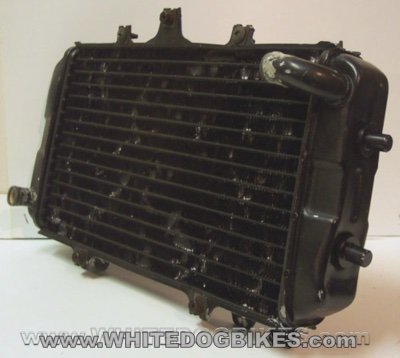
Kawasaki ZX400H radiator.
Useless stuff…
The ‘little brother’ of the Kawasaki ZXR750…… The ZXR400 was originally produced for the Japanese market (where the engine size/license restrictions mean bikes above 400cc aren’t very popular!) but loads of these were imported into the UK in the 1990’s and early 2000’s when bike prices were high. The ZXR400 is still popular today, the low seat height makes it popular with female bikers and the lower insurance and good specs (upside down forks etc) make it popular with newer sportsbike riders.
The ZXR400 also had good handling (as was often commented with 400cc import bikes it felt like it was on rails going round corners!), combined with the howling inline 4 cylinder engine and low price made it an ideal track day bike. The bike was better suited to more technical tracks with more corners where it could hold it’s own against the bigger CC rivals.
Buying advice…
Not really much to be wary of with these bikes. Obviously the normal things to be wary of apply (like ex racing bikes as they were popular as track bikes). As with most import bikes, batteries, oil filters, cables and other common parts are easy to get hold of but exhaust parts, fork parts etc can be difficult to source. Some electrical parts are used on other Kawasaki models so are available but stators do wear with age so should be checked. Alloy parts do tend to pit and suffer if it’s been used in all weathers or left outside all year. These are older bikes now, so beware of rotten exhausts, pitted forks etc.
If your thinking of buying one, there are plenty of forums about with owner/riders who can help (like www.zxrworld.co.uk and zxr400ownersclub.co.uk)
Sources / Thanks to…
Alot of the info on this page was taken from a manual we found online (here…)
If you’ve got any questions or comments please feel free to leave them below 🙂
Disclaimer: The information on this page is correct to the best of our knowledge. But the info should NOT be taken as 100% accurate as we can, occasionally make mistakes (and we have had to guesstimate a few bits due to lack of info)!



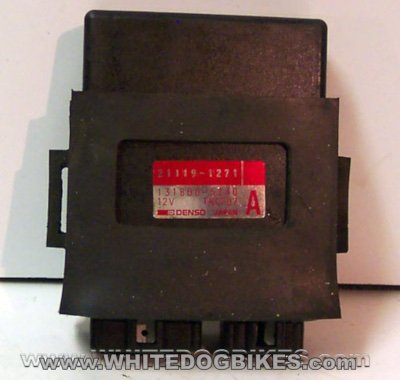

Leave a Reply